Food Storage Guidelines
Proper storage of all types of food products, whether raw meats, dairy, produce or fully prepared foods, is essential in any
branch of the food service industry. Improperly stored food can lead to loss of profits due to waste, food-borne illness due to cross contamination and wasted time while employees search for product.
Meat storage tends to be the most misunderstood and poorly implemented procedure when it comes to food storage. We know that raw meat should always be stored below cooked product, but according to food safety certification MN raw meats should be separated during storage and production. One way to safely store raw products and prevent cross contamination is to make sure that products with the highest cooking temperatures are stored on lower shelves than those with lower temperatures. If raw meats were to be stored on the same rack, a properly organized refrigerator should look like this in descending order.
- Raw steaks and full cuts of beef (145 degrees minimum)
- Raw ground beef (155 degrees)
- Raw poultry (165 degrees)
You will notice that we have not included seafood on our list. Even though seafood has a minimum cooking temperature of 145 degrees, we recommend separating it further from all other product. We feel that this is an important safety precaution to protect those who have allergies to seafood and shellfish.
The optimal way to achieve proper storage is to have dedicated areas for meat, dairy and produce. Larger outlets such as large scale food manufacturing plants can easily achieve this by using multiple refrigeration units. Many restaurants, hotels and smaller institutional facilities do not have this luxury, so diligence is important.
Tips for Streamlining Food Storage
The first tip to ensure proper food storage is to label everything. Food should be labeled and dated when received or prepared. This is the obvious first step, and is required to know for food safety certification in MN, but it is helpful to take labeling one step further than minimum requirements.
Label the sections, shelves and empty spaces in your refrigerators. This will ensure that employees will be able to see where each type of product is allowed to be stored, and will prevent the confusion of a constantly changing storage system.
Another tip is to store produce and meat as far away from each other as possible. In many cases, this can be achieved by splitting refrigeration space in half. One side of a walk-in refrigerator will contain produce, the other meat products. Two separate refrigerators would be the ideal storage solution, but this is not always achievable. In cramped quarters, the labeling of all available space will streamline your storage process.
Proper food storage appears simple on paper, but implementing an organized system is well worth the vigilance.



